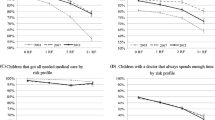Abstract
We examined the predictors for successful discharge from out-of-home care of children with complex needs placed in a novel comprehensive service intervention (Manatee Model) and compared their discharge experiences to their out-of-home counterparts from the same county. The study design consisted of a longitudinal two-year comparison of these two groups. A total of 147 cases were included in the analysis, and the propensity scoring technique was used to equate the groups. Among children admitted to the Manatee Model, boys, White children, younger children, those who came from a single-parent family, those who were abused, and those who had a disability (physical or emotional disability or medical condition) were found less likely to successfully exit within the two years when these predictors were examined separately. Multivariate analyses indicated that only age at the time of removal and health status were significantly associated with successful discharge. Implications of the findings are discussed.

Similar content being viewed by others
References
Bass, S., Shields, M. K., & Behrman, R. E. (2004). Children, families, and foster care: analysis and recommendations. The Future of Children, 14, 5–29.
Benedict, M. I., & White, R. B. (1991). Factor associated with foster care length of stay. Child Welfare League of America, LXX, 45–59.
Browne, D. (2002). Coping alone: Examining the prospects of adolescent victims of child abuse placed in foster care. Journal of Youth and Adolescence, 31, 57–66.
Cochran, W. G. (1968). The planning of observational studies of human populations. Journal of the Royal Statistical Society, 128, 234–255.
Courtney, M. E., & Wong, Y. I. (1996). Comparing the timing of exits from substitute care. Children and Youth Services Review, 18, 307–334.
Cox, D. R. (1972). Regression models and life tables. Journal of the Royal Statistical Society, 34, 187–220.
DosReis, S., Zito, J. M., Safer, D. J., & Soeken, K. L. (2001). Mental health services for youths in foster care and disabled youths. American Journal of Public Health, 91, 1094–1099.
English, D. J., Brandford, C. C., & Coghlan, L. (2000). Data-based organizational change: The use of administrative data to improve child welfare programs and policies. Child Welfare League of America, LXXIX, 500–515.
Fernandez, E. (1999). Pathways in substitute care: Representation of placement careers of children using event history analysis. Children and Youth Services Review, 21, 177–216.
Florida Statute, Section 409.1677 (2001). Model comprehensive residential services programs. Florida Legislative Session.
Goerge, R. (1990). The reunification process in substitute care. Social Service Review, 64, 422–457.
Hussey, D. L., & Guo, S. G. (2002). Profile characteristics and behavioral change trajectories of young residential children. Journal of Child and Family Studies, 11, 401–410.
Jones, L. (1998). The social and family correlates of successful reunification of children in foster care. Children and Youth Services Review, 20, 305–323.
Kaplan, E. L., & Meier, P. (1958). Nonparametric estimation from incomplete observations. Journal of the American Statistical Association, 53, 457–481.
Kerman, B., Wildfire, J., & Barth, R. P. (2002). Outcomes for young adults who experienced foster care. Children and Youth Services Review, 24, 319–344.
Kershaw, M. A., Jordan, N., Armstrong, M. I., Styles, M. C., & Reyes, F. C. (2003). An Evaluation of Comprehensive Residential Group Care (Models and Enhanced Programs) FY02-03. Tampa: University of South Florida, Department of Child and Family Studies.
McMurty, S. L., & Lie, G. Y. (1992). Differential exit rates of minority children in foster care. Social Work Research & Abstracts, 28, 42–48.
Potter, C. C., & Klein-Rothschild, S. (2002). Getting home on time: Predicting timely permanence for young children. Child Welfare League of America, LXXXI, 123–151.
Rosenbaum, P. R., & Rubin, D. B. (1984). Reducing bias in observational studies using subclassification on the propensity score. Journal of the American Statistical Association, 79, 516–524.
Rubin, D. B., & Thomas, N. (1996). Matching using estimated propensity scores: Relating theory to practice. Biometrics, 52, 249–264.
Senate Bill 1214, (2001). Sections 409.1676, 1677, F. S.
Shadish, W. R., Cook, T. D., & Campbell, D. T. (2002). Experimental and Quasi-Experimental Designs for Generalized Causal Inference. Boston: Houghton Mifflin.
Takayama, J. I., Wolfe, E., & Coulter, K. P. (2001). Relationship between reason for placement and medical findings among children in foster care. Pediatrics, 101, 210–207.
U.S. Department of Health and Human Services, Administration for Children and Families, Administration on Children, Youth and Families, Children's Bureau. (2003). AFCARS, Report # 8. Washington, DC: U.S. Government Printing Office.
Vogel, C. A. (1999). Using administrative databases to examine factors affecting length of stay in substitute care. Children and Youth Services Review, 21, 677–690.
Wells, K., & Guo, S. (1999). Reunification and reentry of foster children. Children and Youth Services Review, 21, 273–294.
Author information
Authors and Affiliations
Corresponding author
Rights and permissions
About this article
Cite this article
Yampolskaya, S., Kershaw, M.A. & Banks, S. Predictors of successful discharge from out-of-home care among children with complex needs. J Child Fam Stud 15, 190–200 (2006). https://doi.org/10.1007/s10826-006-9052-y
Published:
Issue Date:
DOI: https://doi.org/10.1007/s10826-006-9052-y



